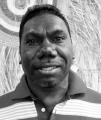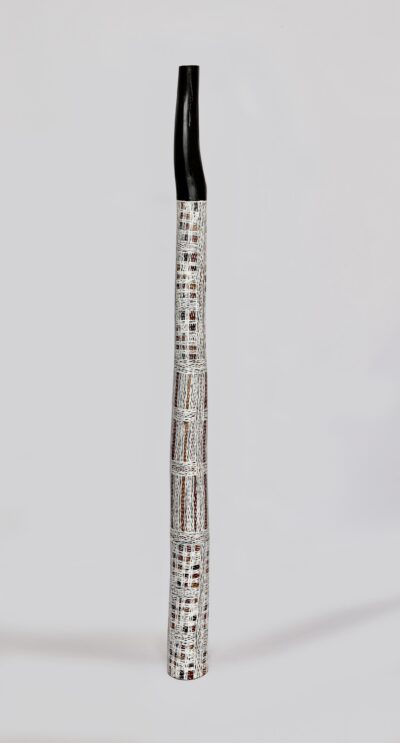Description
Yimula Munungurr and Winiwini Gurruwiwi
Earth pigment on stringybark hollow pole
166 x 14cm
Year: 2024
ID: 0969a-25/0969b-25
Key: D/E
Drone horn tone
Yiḏaki are didjeridus that are specific to North East Arnhem land in Australia’s Northern Territory, where the instrument originates. The term yiḏaki is used in Yolŋu (the nation of North East Arnhem land Aboriginal people) languages as the generic name for the didjeridu. The name yiḏaki is most correctly used for instruments from this region that have been solely made and decorated by Yolŋu people.
Yiḏaki were originally limited to the northern extremes of Australia, in particular Arnhem land. In relatively recent years, yiḏaki spread to other parts of Australia and the rest of the world. Yiḏaki began to be manufactured in different ways and with different types of materials. It became commonly known as the didjeridu, a non-Aboriginal term for the instrument. Through it’s international popularisation as the didjeridu, it has been somewhat displaced from it’s spiritual and cultural roots that are still held by the Yolŋu in Arnhem land today. The Yolŋu are masters of making and playing the yiḏaki and are well known internationally for their quality instruments and complex yiḏaki playing styles.
Yolŋu artists carefully select naturally occurring termite hollowed tree stems, which are cut and shaped into suitable sounding instruments. They are made with certain desired acoustics that can vary dramatically between different clans, from high pitch to very low. Typical yiḏaki have small natural wooden mouthpieces around 30mm in diameter and taper out to a diameter of around 100mm at the distal end. Having a small mouthpiece means they require less air to play and produce sound easily as a result.
In appearance yiḏaki seem to be a simple instrument, however the playing styles of the Yolŋu are complex and require many years of practice. Yiḏaki are played by vibrating the lips which produces a basic tone. This tone is maintained continually using cyclic breathing and is varied through use of the playing pressure, the tension in the cheeks, the use of the diaphragm, the tongue position and the use of the voice.
Traditionally, yiḏaki are painted with naturally occurring red, white, black and yellow earth pigments. In recent years acrylic paints began to be used. Both the artwork and the sound and overall style of the yiḏaki denote cultural history and law.
The cross hatching grid pattern is the sacred design for the freshwaters of the Djapu clan at their homeland Wandawuy now an outstation about 150 kilometres south of Yirrkala and inland from Blue Mud Bay.
This Djapu clan outstation (and spiritual residence for ancestral beings Mäna the shark and Bol’ŋu the Thunderman) is surrounded by permanent freshwater. Rains inspired by the actions of Bol’ŋu feed the rivers and fill the billabongs. Catfish and mussels, freshwater crayfish and others feed the Yolŋu and wild life. The waters are home for the shark Mäna.
The grid refers to the landscape of Wandawuy – a network of billabongs surrounded by ridges and high banks. Its structure also having reference at one level to woven fish traps. Ancestral hunters who set a trap here are called Bärngbarng and Monu’a who came to cut the trees named Gu’uwu, Gathurrmakarr, Nyenyi, Rulwirrika and Gananyarra – all Dhuwa trees. They used straight young trees and cut them with their axes called Gayma’arri, Bitjutju.
Areas of the river are staked by the Yolŋu and branches interwoven through them. Then the water is polluted by a particular pulped bark that anaesthetizes the Gaṉŋal that hobble to the surface. With nets constructed similarly to the the beak of Galumay the pelican the Yolŋu wade through the waters scooping up the fish. It has been fished since ancestral times. Gaṉŋal the catfish, totem for the Djapu is ceremonially sung as is Galumay the pelican. Both these species frequent the waters of Wandawuy.
Mäna the ancestral shark in its epic travels comes through this way. These ancestors try to trap Mäna in the freshwater by means of these traps in the waterways. They fail. The powers and physical strength of the shark overcome the efforts of mere mortals. Mäna’s ire and thrashing tail smash the trap and muddy the water. They witness however the strength of Mäna and sing his actions, the thrashing of his tail for one, the muddying or contamination of the water.
The grid lines have reference to the trap, the cross hatched squares referring to differing states of the freshwater – the source of Djapu soul. At ceremony appropriate participants for mortuary rites enter the shelter (woven together like the unsuccessful trap) where the deceased has been lying in state. Sacred spears tipped with stingray barbs, manifestations of Mäna’s teeth, stand up alongside the shelter. The sacred song cycles of Mäna in the water at Wandawuy are intoned with music from the yiḏaki (didjeridu) and Bilma (clapsticks). At the prescribed time at the conclusion of ceremony the dancers crash through the deceased’s shelter imitating the actions of Mäna at the trap. This action has reference to the release of the deceased’s soul, back to the sacred waters of Wandawuy to be reunited with its ancestors awaiting rebirth.
Wandawuy literally means place of the sharks head where in the larger context of the song cycles of Mana’s journey his head came to rest after being butchered and distributed through the land.







Reviews
There are no reviews yet.